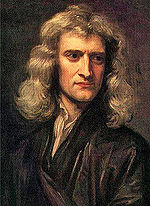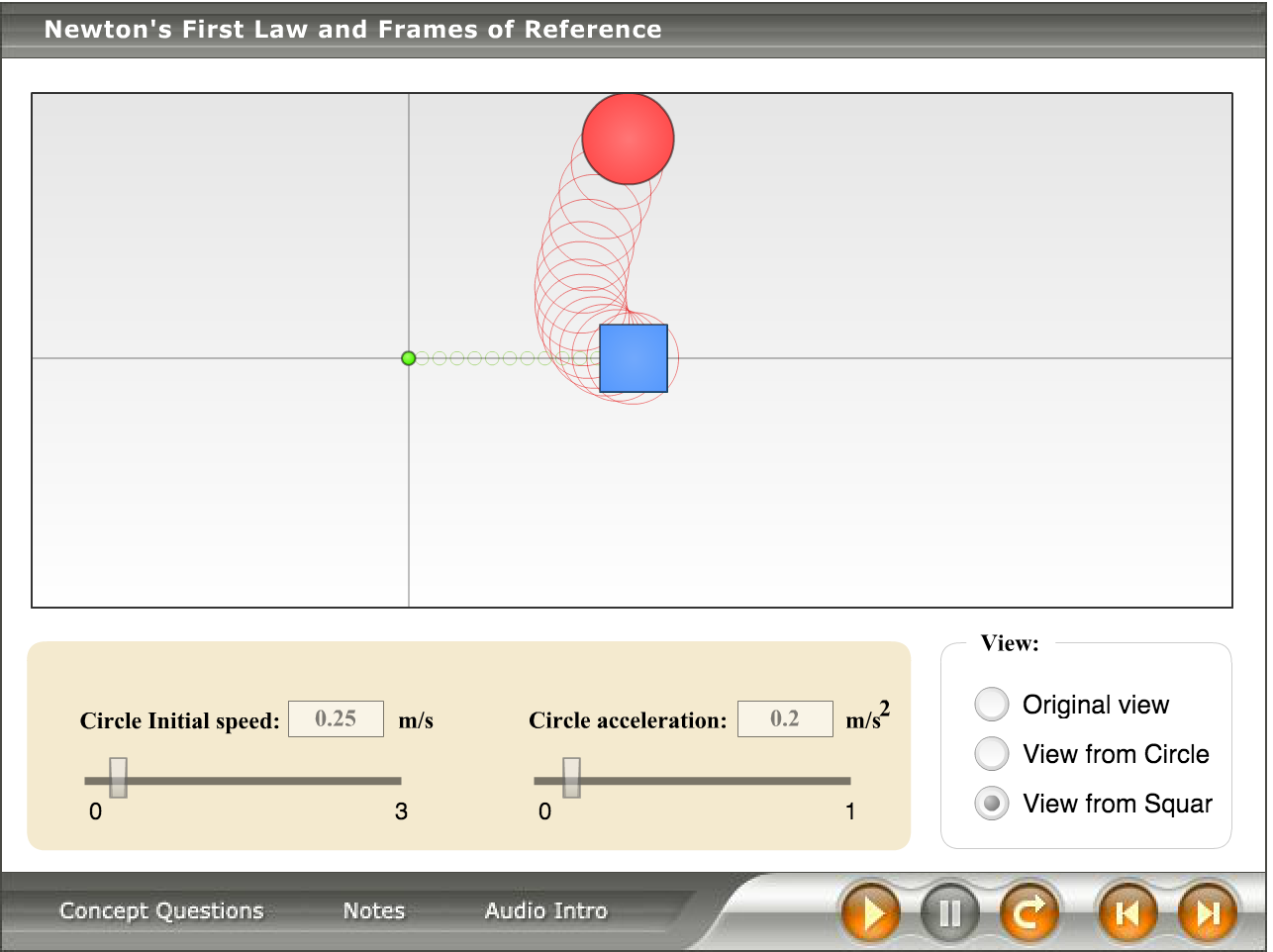Frame of Reference
Created by Abhinav Sundaresan

The frame of reference is a tool that can be used to change the way in which a system is viewed, thus adding a layer of complexity but in some cases simplifying the problem.
The Main Idea
A frame of reference is the point in the way or perspective from which you view the events that take place within a system. In this class we use inertial frames of reference (frames where the velocity is constant). It is easy to think about if you imagine a person and what they would see if they were standing where you want a frame of reference to be. Consider the below example where there are two frames of reference: The one that observes the whole train and the boy and the one from the point of view of the boy on the train.
To the first observer (and his frame of reference), the boy is moving to the right along with the train. To the boy on the train (and his different frame of reference), he is standing still on the train. Here is a basic example of how changing the frame of reference can be a very powerful tool.
A Mathematical Model
In order to calculate what the velocity is, we will use the following equation so that the frame of reference will not change the overall value of the velocity:
[math]\displaystyle{ \vec{v} = \vec{v}' + \vec{v}_{frame} }[/math]
where [math]\displaystyle{ \vec{v} }[/math] is the velocity in a stationary frame, [math]\displaystyle{ \vec{v}_{frame} }[/math] is the velocity of the moving reference frame, and [math]\displaystyle{ \vec{v}' }[/math] is the velocity observed in the moving frame.
A Computational Model
There are some great resources that can help you become more acquainted with the topic of frames of reference.
The following website allows you to change initial conditions and frames of reference to see exactly how your decisions will change what is seen: http://www.wiley.com/college/halliday/0470469080/simulations/sim45/sim45.html
Also, here are two YouTube videos that do a great job of breaking down frames of reference so that they can be easily understood:
https://www.youtube.com/watch?v=mYH_nODWkqk
https://www.youtube.com/watch?v=jYMU6bn5GHY
Examples
Be sure to show all steps in your solution and include diagrams whenever possible
Simple
Say that you are pulled over on the side of the road and a car passes by you at a speed of 50 m/s. You then start to drive at a speed of 43 m/s and you see the car that just drove by in from of you. What is the speed of the car from your moving frame of reference?
As we know,
[math]\displaystyle{ \vec{v} = \vec{v}' + \vec{v}_{frame} }[/math]
In this scenario, [math]\displaystyle{ \vec{v} = 50 m/s }[/math] since that is the velocity from our initial stationary reference frame. [math]\displaystyle{ \vec{v}_{frame} = 43 m/s }[/math] because that is now the velocity of our frame of reference, meaning that [math]\displaystyle{ \vec{v}' }[/math] is what we are solving for.
Plugging in what we know, [math]\displaystyle{ 50 m/s = 43 m/s + \vec{v}' }[/math]
This means that [math]\displaystyle{ \vec{v}' = 7 m/s }[/math]
Middling
You are in a boat <480,140,620> meters in 8 seconds. You see a plane below you and to you it looks like it has a velocity of <50,23,62> m/s. What would the velocity of the second plane be to a stationary observer?
[math]\displaystyle{ Δx = v * t }[/math]
[math]\displaystyle{ Δx = \lt 480,140,620\gt meters }[/math]
[math]\displaystyle{ t = 8 seconds }[/math]
Therefore,
[math]\displaystyle{ v = \lt 60,17.5,77.5\gt m /s }[/math]
Also,
[math]\displaystyle{ \vec{v} = \vec{v}' + \vec{v}_{frame} }[/math]
In this scenario, [math]\displaystyle{ \vec{v}_{frame} = \lt 60,17.5,77.5\gt m /s }[/math] and [math]\displaystyle{ \vec{v}' = \lt 50,23,62\gt }[/math], meaning that [math]\displaystyle{ \vec{v} }[/math] is what we are solving for.
Plugging in what we know, [math]\displaystyle{ \vec{v} = \lt 60,17.5,77.5\gt m/s + \lt 50,23,62\gt m/s }[/math]
This means that [math]\displaystyle{ \vec{v} = \lt 110,40.5,139.5\gt m/s }[/math]
Difficult
You are in an airplane and you travel a distance of <480,140,620> meters in 8 seconds. You see a plane below you and to you it looks like it has a velocity of <50,23,62> m/s. What would the velocity of the second plane be to a stationary observer?
As we know,
[math]\displaystyle{ Δx = v * t }[/math]
[math]\displaystyle{ Δx = \lt 480,140,620\gt meters }[/math]
[math]\displaystyle{ t = 8 seconds }[/math]
Therefore,
[math]\displaystyle{ v = \lt 60,17.5,77.5\gt m /s }[/math]
Also,
[math]\displaystyle{ \vec{v} = \vec{v}' + \vec{v}_{frame} }[/math]
In this scenario, [math]\displaystyle{ \vec{v}_{frame} = \lt 60,17.5,77.5\gt m /s }[/math] and [math]\displaystyle{ \vec{v}' = \lt 50,23,62\gt }[/math], meaning that [math]\displaystyle{ \vec{v} }[/math] is what we are solving for.
Plugging in what we know, [math]\displaystyle{ \vec{v} = \lt 60,17.5,77.5\gt m/s + \lt 50,23,62\gt m/s }[/math]
This means that [math]\displaystyle{ \vec{v} = \lt 110,40.5,139.5\gt m/s }[/math]
Connectedness
- I have always been interested in how we perceive the world around us and take measurements. It had never occurred to me that something as simple as speed could change based on the observer and so researching and understanding this topic proved to be very fun and interesting.
- This topic has nothing to do with my current major of Computer Science.
- Analyzing frames of reference can provide many key insights in industrial settings. Whether it be looking at colliding particles in the LHC or why the speed of light is the absolute speed limit of the universe, looking at these things can help scientists understand the world around us and hopefully make great inventions based of these results.
History

Although it is not known who came up with this concept of reference frames, it has been key to interpreting and understanding the world around us. Newton assumed a Euclidean space when looking at frames of reference which he used when he came up with important ideas and theories such as gravity. Einstein came up with transformations between reference frames to come up with his special theory of relativity. These are just some examples of how frames of reference have been used through the history of science and man.
See also
Relevant Materials
Further reading
Matter and Interactions Fourth Edition By Ruth W. Chabay, Bruce A. Sherwood - Chapter 10 Section 5
External links
- 1: https://www.youtube.com/watch?v=mYH_nODWkqk
- 2: https://www.youtube.com/watch?v=jYMU6bn5GHY
- 3: http://www.wiley.com/college/halliday/0470469080/simulations/sim45/sim45.html
- 4: https://www.khanacademy.org/science/physics/forces-newtons-laws/newtons-laws-of-motion/v/newton-s-first-law-of-motion
References
- 1: Chabay, Ruth W., and Bruce A. Sherwood. Matter and Interactions. Hoboken, NJ: Wiley, 2011. Print.
- 2: "Frames of Reference." Isaac Physics. N.p., n.d. Web. <https://isaacphysics.org/concepts/cp_frame_reference>.
- 3: "Reference Frame." Everthing Maths & Science. N.p., n.d. Web. <http://www.everythingmaths.co.za/science/grade-10/21-motion-in-one-dimension/21-motion-in-one-dimension-02.cnxmlplus>.
- 4: Wikipedia. Wikimedia Foundation, n.d. Web. <https://en.wikipedia.org/wiki/Frame_of_reference#Remarks>.
- 5: Wikipedia. Wikimedia Foundation, n.d. Web. <https://en.wikipedia.org/wiki/Inertial_frame_of_reference>.

